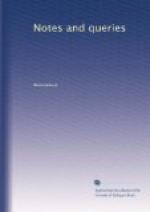COLL. ROYAL SOC.
Jeremy Taylor’s Works (Vol. ii., p. 271.).—It seems desirable that an advance should occasionally be made in editing, beyond the mere verification of authorities, in seeing, that is, whether the passages cited are applicable to the point in hand, and properly apprehended. Bp. Taylor, in his Liberty of Prophecying, sect. vi., for instance, seems incorrect in stating that Leo I., bishop of Rome, rejected the Council of Chalcedon; whereas his reproofs are directed against Anatolias, bishop of Constantinople, an unwelcome aspirant to ecclesiastical supremacy. (See Concilia Studio Labbei, tom. iv., col. 844, &c.)
A passage frown Jerome’s Epistle to Evangelus is often quoted in works on church government, as equalising, or nearly so, the office of bishop and presbyter; but the drift of the argument seems to be, to show that the site of a bishop’s see, be it great or small, important or otherwise, does not affect the episcopal office. Some readers will perhaps offer an opinion on these two questions.
NOVUS.
Ductor Dubitantium.—The Judge alluded to by Jeremy Taylor in the passage quoted by A.T. (Vol. ii., p. 325.), was Chief-Justice Richardson; but the place where the outrage was committed was not Ludlow, as stated by the eloquent divine, but Salisbury, as appears from the following marginal note in Dyer’s Reports, p. 1886—a curious specimen of the legal phraseology of the period:—
“Richardson, C.J. de C.B. at Assizes at Salisbury in Summer 1631 fuit assault per Prisoner la condemne pur Felony; que puis son condemnation ject un Brickbat a le dit Justice, que narrowly mist. Et pur ceo immediately fuit Indictment drawn pur Noy envers le Prisoner, et son dexter manus ampute et fixe al Gibbet, sur que luy mesme immediatement hange in presence de Court.”
EDWARD FOSS.
Aerostation (Vol. ii., p. 317.).—The account published by Lunardi of his aerial voyage, alluded to by M., is, in the copy I have seen, entitled
“An Account of the First Aerial Voyage in Britain, in a series of letters to his guardian, the Chevalier Gherardo Compagni, written under the impressions of the various events that affected the undertaking, by Vicent Lunardi, Esq., Secretary to the Neapolitan Ambassador. ’A non esse nec fuisse non datur argumentum ad non posse.’ Second edition, London: printed for the Author, and sold at the Panther; also by the Publisher J. Bell, at the British Library, Strand, and at Mr. Molini’s, Woodstock Street, MDCCLXXXIV.”
The book contains printed copies of the depositions of witnesses who beheld Lunardi’s descent; and Mr. Baker, who, as a magistrate, took those depositions on oath, to establish what he thought so wonderful a fact, erected on the spot where the balloon descended, in a field near Colliers End, in the parish of Standon, Herts, on the left of the high road from London to Cambridge, a stone with the following inscription on a copper plate. It is still {381} legible, though somewhat defaced. It is engraved in lines of unequal length, but to save your space I have not adhered to those divisions.




